Extinct giants. Prehistoric Animals - Quick Interesting Facts
Prehistoric mammals are giant animals that lived on Earth millions of years ago and disappeared from our planet forever.
Giant sloths- a group of several different species of sloths, notable for their particularly large sizes. They arose in the Oligocene about 35 million years ago and lived on the American continents, reaching a weight of several tons and a height of 6 m. Unlike modern sloths, they lived not in trees, but on the ground. They were clumsy, slow animals with low, narrow skulls and very little brain matter. Despite its great weight, the animal stood on its hind legs and, leaning its forelimbs on the tree trunk, reached for succulent leaves. Leaves were not the only food of these animals. They also ate cereals, and perhaps did not disdain carrion. People settled the American continent between 30 and 10 thousand years ago, and the last giant sloths disappeared from the continent about 10 thousand years ago. This suggests that these animals were hunted. They were probably easy prey because, like their modern relatives, they moved very slowly. Giant sloths lived from 35 million to 10 thousand years ago.
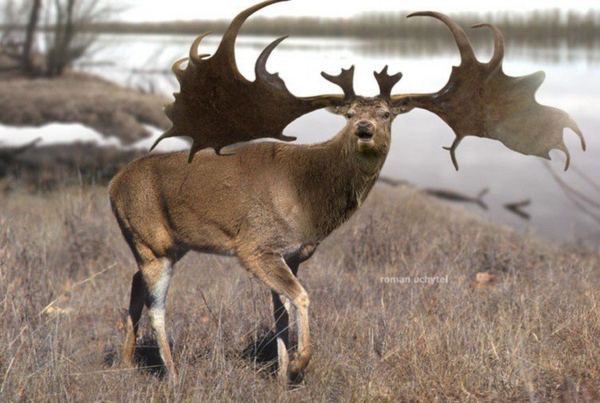
Megaloceros (lat. Megaloceros giganteus) or big-horned deer, appeared about 300 thousand years ago and died out at the end of the Ice Age. Inhabited Eurasia, from British Isles before China, preferred open landscapes with sparse woody vegetation. The big-horned deer was the size of a modern elk. The male's head was decorated with colossal horns, greatly expanded at the top in the shape of a spade with several branches, with a span of 200 to 400 cm, and weighing up to 40 kg. Scientists do not have a consensus on what led to the emergence of such huge and, apparently, inconvenient jewelry for the owner. It is likely that the luxurious horns of males, intended for tournament fights and attracting females, greatly interfered with Everyday life. Perhaps, when forests replaced the tundra-steppe and forest-steppe, it was the colossal horns that caused the extinction of the species. He could not live in the forests, because with such a “decoration” on his head it was impossible to walk through the forest.
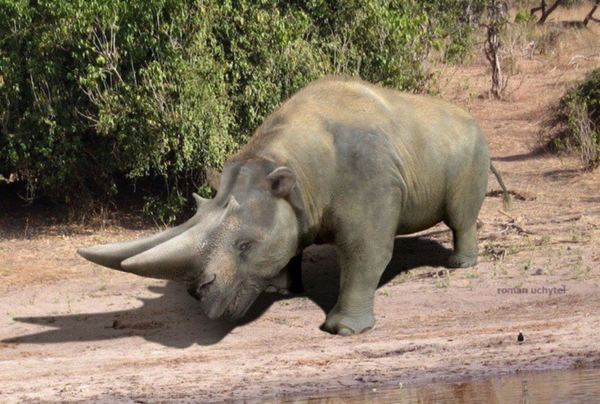
Arsinotherium (lat. Arsinoitherium)- an ungulate that lived approximately 36-30 million years ago. It reached a length of 3.5 meters and was 1.75 m in height at the withers. Outwardly, it resembled a modern rhinoceros, but retained all five toes on its front and hind legs. Its “special feature” were huge, massive horns, consisting not of keratin, but of a bone-like substance, and a pair of small outgrowths of the frontal bone. Remains of Arsinotherium are known from Lower Oligocene deposits of northern Africa (Egypt). Arsinotherium lived 36-30 million years ago.
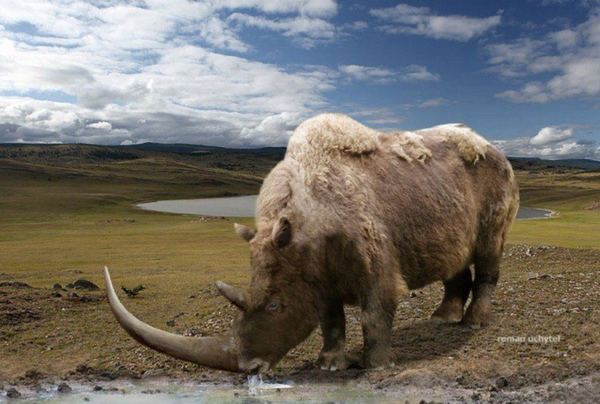
Coelodonta antiquitatis- fossil woolly rhinoceroses, adapted to life in the arid and cool conditions of the open landscapes of Eurasia. They existed from the late Pliocene to the early Holocene. They were large, relatively short-legged animals with a high nape and an elongated skull bearing two horns. The length of their massive body reached 3.2 - 4.3 m, height at the withers - 1.4 - 2 meters. A characteristic feature of these animals was a well-developed woolly coat, which protected them from low temperatures and cold winds. The low-set head with square lips made it possible to collect the main food - the vegetation of the steppe and tundra-steppe. From archaeological finds it follows that the woolly rhinoceros was hunted by Neanderthals about 70 thousand years ago. Celodonts Lived from 3 million to 70 thousand years ago.
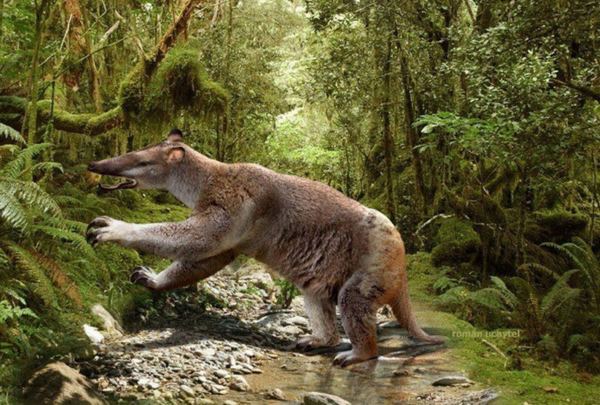
Palorchestes (lat. Palorchestes azael)- a genus of marsupials that lived in Australia in the Miocene and became extinct in the Pleistocene about 40 thousand years ago, after humans arrived in Australia. Reached 1 meter at the withers. The animal's muzzle ended with a small proboscis, for which Palorchests are called marsupial tapirs, to which they are somewhat similar. In fact, palorchests are quite close relatives of koalas. The Palorchestes lived from 15 million to 40 thousand years ago.
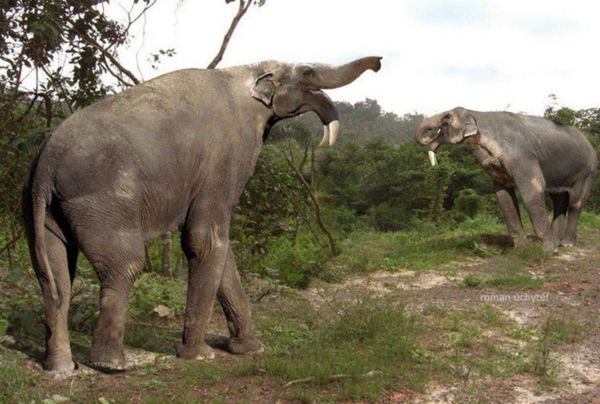
Deinotherium giganteum- the largest land animals of the late Miocene - middle Pliocene. The body length of representatives of various species ranged from 3.5-7 meters, height at the withers reached 3-5 meters, and weight could reach 8-10 tons. Outwardly, they resembled modern elephants, but differed from them in proportions. Deinotherium lived from 20 to 2 million years ago.
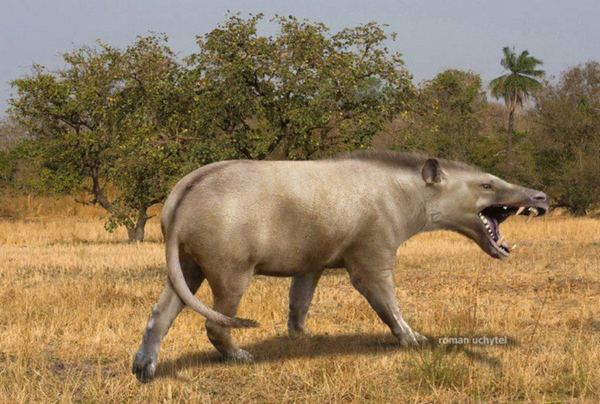
Andrewsarchus (lat. Andrewsarchus), perhaps the largest extinct terrestrial predatory mammal that lived during the Middle - Late Eocene era in Central Asia. Andrewsarchus is represented as a long-bodied, short-legged beast with a huge head. The length of the skull is 83 cm, the width of the zygomatic arches is 56 cm, but the dimensions can be much larger. According to modern reconstructions, if we assume relatively large head sizes and shorter leg lengths, then the body length could reach up to 3.5 meters (without the 1.5 meter tail), the height at the shoulders could be up to 1.6 meters. Weight could reach 1 ton. Andrewsarchus is a primitive ungulate, close to the ancestors of whales and artiodactyls. Andrewsarchus lived from 45 to 36 million years ago.
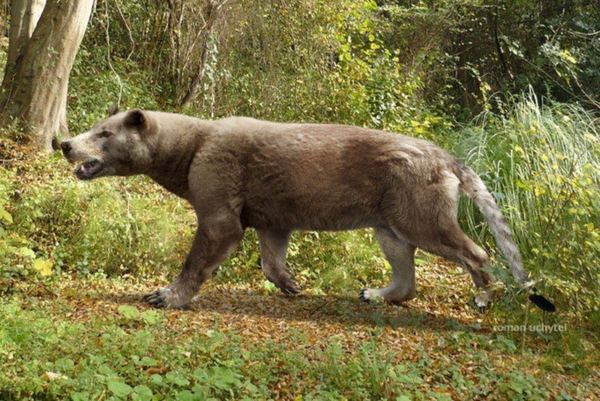
Amphicyonids (lat. Amphicyon major) or dog-bears became widespread in Europe and western Turkey. The proportions of the Amphicyonidae were a mixture of bear and dog features. His remains were found in Spain, France, Germany, Greece and Turkey. The average weight of male Amphicyonids was 210 kg, and females - 120 kg (almost the same as modern lions). The amphicyonid was an active predator, and its teeth were well adapted for crunching bones. Amphicyonids lived from 16.9 to 9 million years ago.
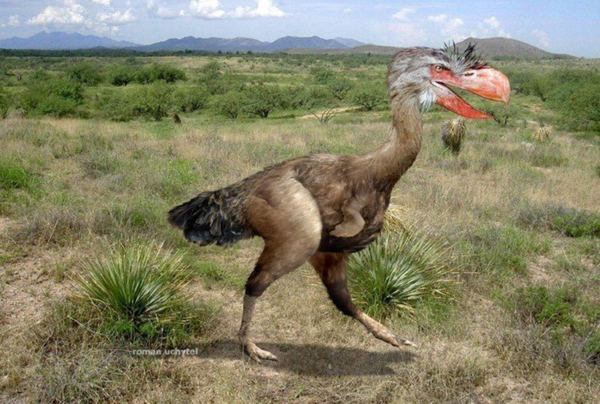
Terrible Birds(sometimes called fororakosov), who lived 23 million years ago. They differed from their counterparts in their massive skull and beak. Their height reached 3 meters, weighed up to 300 kg and were formidable predators. Scientists created a three-dimensional model of the bird's skull and found that the bones of the head were strong and rigid in the vertical and longitudinal-transverse directions, while in the transverse direction the skull was quite fragile. This means that the fororacos would not be able to grapple with struggling prey. The only option is to beat the victim to death with vertical blows of the beak, as if with an ax. The only competitor to the terrible bird was most likely the marsupial saber-toothed tiger (Thylacosmilus). Scientists believe that these two predators were once at the top of the food chain. Thylacosmil was a stronger animal, but Paraphornis surpassed it in speed and agility. Fororakos lived 23 million years ago.
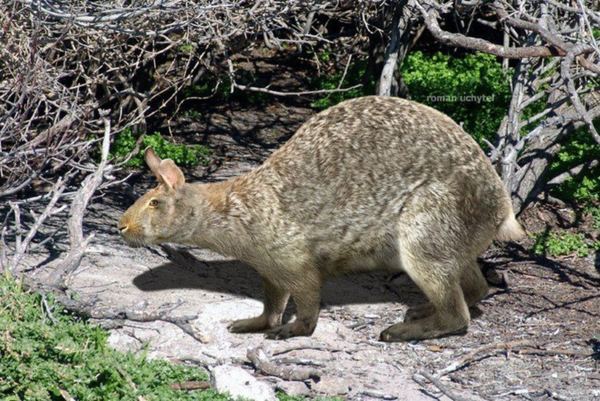
In the family hares (Leporidae), also had their giants. In 2005, a giant hare was described from the island of Menorca (Balearics, Spain), which received the name Giant Menorcan hare (lat. Nuralagus rex). The size of a dog, it could reach a weight of 14 kg. According to scientists, such a large size of the rabbit is due to the so-called island rule. According to this principle, large species, once on the islands, decrease over time, while small ones, on the contrary, increase. Nuralagus had relatively small eyes and ears, which did not allow him to see and hear well - he did not have to fear an attack, because. was not on the island large predators. In addition, scientists believe that due to reduced paws and rigidity of the spine, the “king of hares” lost the ability to jump and moved on land exclusively in small steps. The giant Minorcan hare lived from 7 to 5 million years ago.
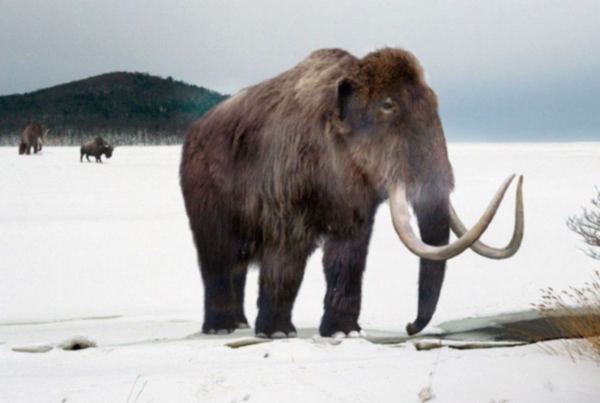
Woolly mammoth (lat. Mammuthus primigenius) appeared 300 thousand years ago in Siberia, from where it spread to North America and Europe. The mammoth was covered with coarse wool, up to 90 cm long. A layer of fat almost 10 cm thick served as additional thermal insulation. The summer coat was significantly shorter and less dense. They were most likely painted dark brown or black. With small ears and a short trunk compared to modern elephants, the woolly mammoth was well adapted to cold climates. Woolly mammoths were not as huge as is often assumed. Adult males reached a height of 2.8 to 4 m, which is not much larger than modern elephants. However, they were significantly more massive than elephants, reaching a weight of up to 8 tons. A noticeable difference from living species of proboscis was the strongly curved tusks, a special growth on the top of the skull, a high hump and a steeply sloping rear part of the back. The tusks found to this day reached a maximum length of 4.2 m and a weight of 84 kg. The woolly mammoth lived from 300 thousand to 3.7 thousand years ago.
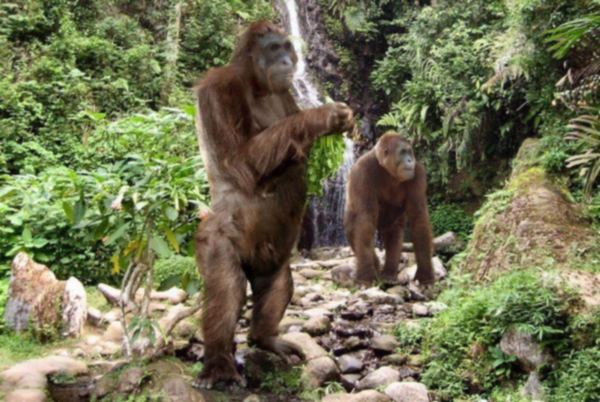
Gigantopithecus (lat. Gigantopithecus)- an extinct genus of apes that lived in the territory modern India, China and Vietnam. According to experts, Gigantopithecus had a height of up to 3 meters and weighed from 300 to 550 kg, that is, they were the largest monkeys of all time. At the end of the Pleistocene, Gigantopithecus may have coexisted with Homo erectus, who began to penetrate Asia from Africa. Fossil remains indicate that Gigantopithecus was the largest primate of all time. They were probably herbivores and walked on all fours, feeding mainly on bamboo, sometimes adding seasonal fruits to their food. However, there are theories that prove the omnivorous nature of these animals. Two species of this genus are known: Gigantopithecus bilaspurensis, which lived between 9 and 6 million years ago in China, and Gigantopithecus blacki, which lived in northern India at least 1 million years ago. Sometimes a third species, Gigantopithecus giganteus, is isolated. Although it is not completely known what exactly caused their extinction, most researchers believe that climate change and competition for food sources from other, more adaptable species - pandas and humans - were among the main reasons. Closest relative from now existing species is an orangutan, although some experts consider Gigantopithecus to be closer to gorillas. Gigantopithecus lived from 9 to 1 million years ago.
Over the past ten thousand years, humanity's impact on the environment has led to the extinction of many beautiful animals. In this article you will learn facts about ten interesting creatures which have already disappeared. Animals died out en masse in two stages, the first was about ten thousand years ago, and the second - five hundred years ago. Each time, many small animals became extinct, but the incredible large creatures attract much more attention. For each extinct species, the approximate date of its extinction is added.
Irish elk, 5200 BC
These extinct giants once lived throughout northern Europe. They have little in common with those existing on this moment species of moose, which is why they are more often called “giant deer.” These animals could reach a two-meter span at the shoulders and weighed seven centners. They had large horns several meters wide. They appeared four hundred thousand years ago, and disappeared five thousand years ago. Most likely, the cause was human hunters. However, it is also possible that the disappearance of ice led to the appearance of other plants, which caused a shortage of essential minerals. For example, it takes a lot of calcium to grow such impressive antlers. 
Quagga, 1883
Half zebra and half horse, this creature was a subspecies of zebra that appeared approximately two hundred thousand years ago. They became extinct in the nineteenth century. Quaggas lived in South Africa and got their name because of the sound they made, based on the onomatopic principle. They were destroyed in 1883 in order to acquire land for agriculture. 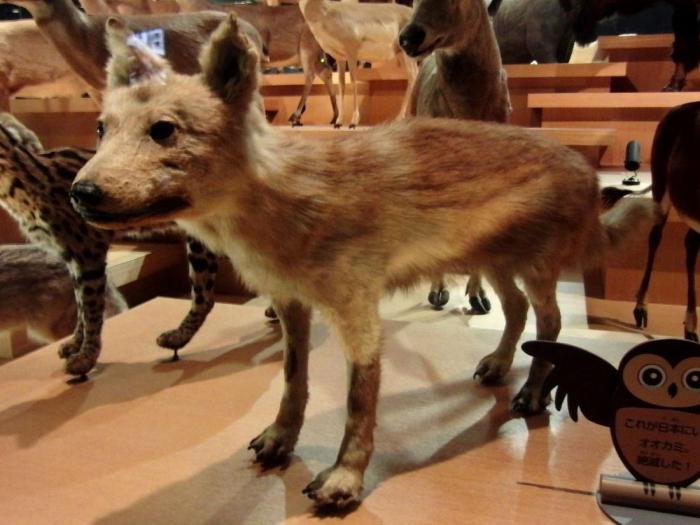
Japanese wolf, 1905
These wolves lived on several Japanese islands. It was rarest species from the family, only a meter in length and with a small shoulder span. When rabies appeared on the islands, the wolf population began to decline dramatically. They began to treat people more aggressively. As a result of deforestation and the subsequent loss of their habitat, they came into more contact with people, and they began to be deliberately destroyed until the last wolf was killed in 1905. 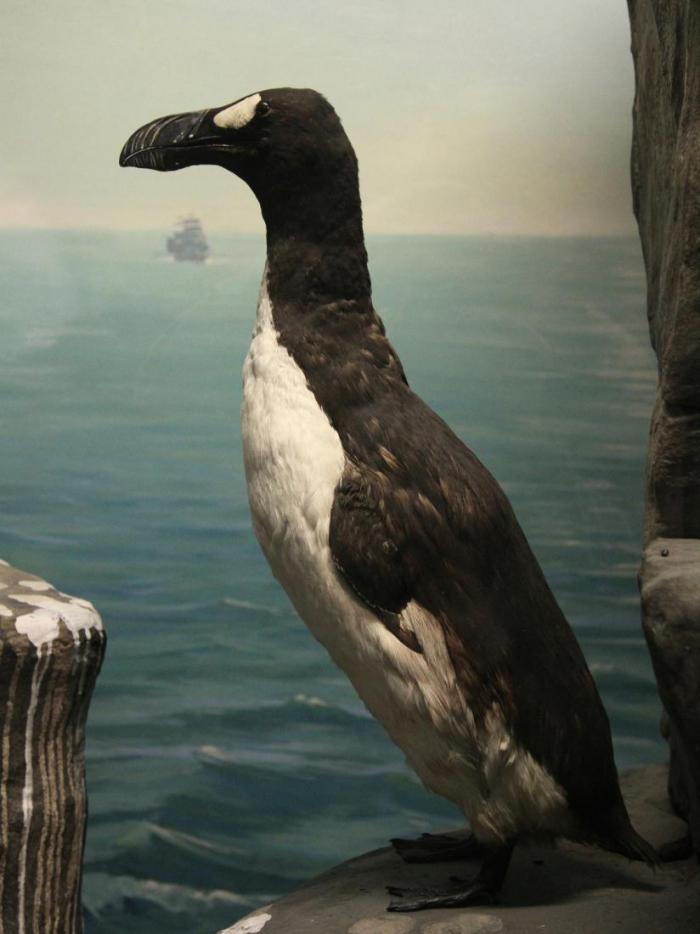
Giant Penguin, 1852
These creatures were very similar to modern penguins. They swam beautifully, stored fat for warmth, lived in large colonies and formed pairs for life. They had large curved beaks. Penguins could grow to almost a meter tall and lived in the north Atlantic until the nineteenth century. People began to hunt them to stuff pillows with valuable feathers. They were then caught to be used as bait for fishing, as well as for consumption. When they became rare, museums and collectors wanted to collect stuffed animals, and so the penguins became extinct. 
Pinta Island Turtles, 2012
This subspecies giant turtles lived in the Galapagos. Turtles have been hunted since the nineteenth century, and in the fifties of the twentieth century their habitat was destroyed. People tried to save the endangered turtles, but by 1971 only one male remained, nicknamed Lonesome George. Despite attempts to crossbreed him with representatives of other species, no eggs appeared, and he himself died in 2012. He was the last of his kind. 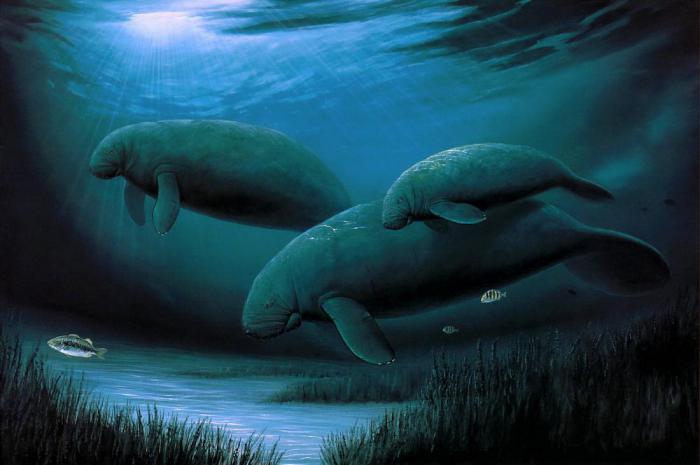
Steller's sea cow, 1768
They were huge herbivores marine mammals, similar to seals. They were distinguished by their gigantic size: they could reach nine meters in length. They were discovered by Georg Wilhelm Steller, but thirty years after their discovery they were completely destroyed. This is because these animals were very calm and lived in shallow water. Their meat was eaten, their fat was used for food, and their skin was used to cover boats.
Smilodon, 10,000 BC
These saber-toothed cats lived in North and South America at the end of the Ice Age. They appeared about two and a half million years ago. Large creatures could reach four hundred kilograms in weight, three meters in length and one and a half meters in shoulder span. Despite the fact that they were called tigers, they rather resembled bears. They had short and powerful legs, not designed for fast movement. The impressive incisors could reach thirty centimeters in length, but were quite fragile and were used to bite through the soft skin of a captured victim. Smilodon could open their mouths one hundred and twenty degrees, but their bite was quite weak. Smilodon hunted large animals: bison, deer and small mammoths. It was difficult for them to catch smaller animals. The disappearance of Smilodon is associated with the appearance of people in these regions, who destroyed many species of animals. 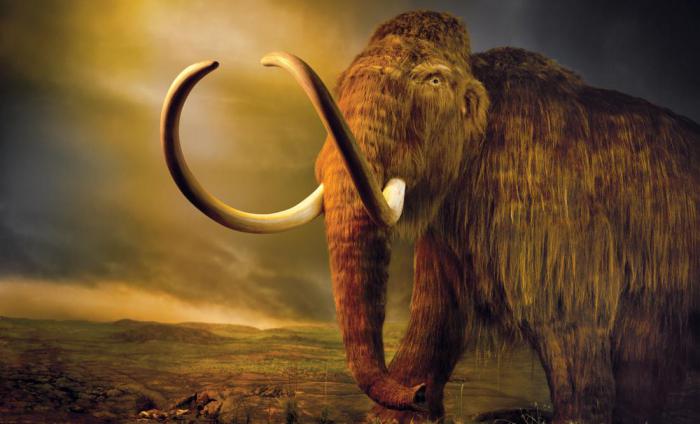
Woolly mammoth, 2000 BC
Woolly mammoths lived in the Arctic tundra regions of the northern hemisphere. They could reach several meters in height and weighed six tons, the same as modern African elephants, although biologically they are closer to Asian ones. Unlike the latter, mammoths were covered with brown, black or red hair. In addition, they had short tails, which protected them from frostbite. Woolly mammoths had long tusks that they used to fight. People hunted them, in addition, they ate mammoth meat as food. However, it is most likely that these animals disappeared due to climate change at the end of the Ice Age. The retreat of the ice led to the disappearance of their habitat, and then hunters completed the situation. Most mammoths went extinct ten thousand years ago, but small populations remained in remote regions for another six thousand years. 
Moa, 1400
Moas were huge birds that were unable to fly. They lived in New Zealand. They could reach almost four meters in height and weighed two hundred and thirty kilograms. Despite their incredible height, the structure of the bird's spine suggests that most time they stretched their necks forward. Thanks to such a neck, they most likely produced low vibrating sounds. Moas were hunted by other birds, as well as members of the Maori tribe. In less than a hundred years after the discovery, people completely destroyed these birds. 
Tasmanian tiger, 1936
The Tasmanian tiger was the largest marsupial predator of our era, appearing four million years ago. They became extinct in the thirties of the last century due to the fault of farmers who destroyed them due to the fact that the animals allegedly killed sheep and chickens. Besides, Agriculture reduced their habitat, and the spread of dogs led to the emergence of various diseases. Amazing creatures lived in Tasmania, Australia and New Guinea; they could reach almost two meters in length from head to tail. Tasmanian tigers were at the top of the food chain and hunted kangaroos, possums and birds at night. Their jaws could open one hundred and twenty degrees, and their stomachs stretched to huge amount food, which allowed them to survive in sparsely populated regions. These were extremely unusual marsupials, since both females and males had a pouch. The latter used it to protect their genitals while running in the grass.
Worth remembering
This list does not include many amazing creatures, such as Javan and Caspian tigers or cave lions. Of course, dodos also deserve mention. It is tragic that human activity has led to the extinction of so many beautiful animals. It's terrible that this continues to this day. The price of hunting is known to everyone, but people continue to destroy animals. One can only hope that the list will not soon be replenished with many other species of animals.
Unseen prehistoric animals
Prehistoric creatures. Ancient animals. Animals of the past.
Animals of the prehistoric period. Animals of the distant past.
Prehistoric animals that lived on different continents thousands and millions of years ago.
Remains of Platybelodon ( Platybelodon) were found for the first time only in 1920 in Miocene deposits (about 20 million years ago) of Asia. Descended from the archaeobelodon (genus Archaeobelodon) from the early and middle Miocene of Africa and Eurasia and was in many ways similar to the elephant, except that it did not have a trunk, the place of which was taken by huge jaws.
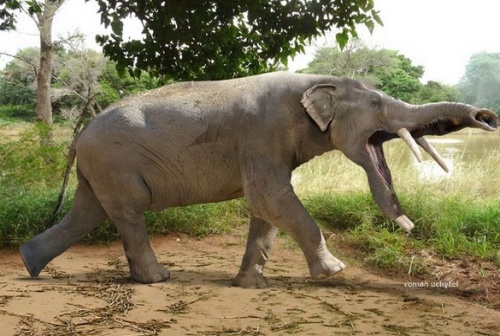
Platybelodon went extinct towards the end of the Miocene, about 6 million years ago, and no animal with such an unusual mouth shape exists today. Platybelodon had a dense build and reached 3 meters at the withers. It probably weighed approximately 3.5-4.5 tons. There were two pairs of tusks in the mouth. The upper tusks were round in cross-section, like those of modern elephants, while the lower tusks were flattened and spade-shaped. With its spade-shaped lower tusks, Platybelodon apparently rummaged in the ground in search of roots or stripped bark from trees. Platybelodon belongs to the order of proboscis - Proboscidea, to the superfamily Elephantoidea, which in Russian can be formulated as elephant-shaped.
Pakicetus (Pakicetus) is an extinct predatory mammal belonging to the archaeocetes. The oldest known ancestor of the modern whale, it lived approximately 48 million years ago and adapted to foraging in water. Lived in the territory of modern Pakistan. This primitive “whale” still remained an amphibian, like the modern otter. The ear had already begun to adapt to hear underwater, but could not yet withstand the great pressure.
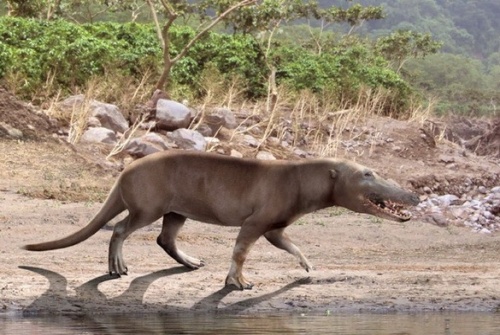
He had powerful jaws that marked him as a predator, close-set eyes and a muscular tail. The sharp teeth were adapted to grab slippery fish. He probably had webbing between his fingers. The main feature is that its ankle bones are most similar to those of pigs, sheep and hippos. The cranial bones are very similar to those of whales.
Arsinotherium (Arsinoitherium) - an ungulate that lived approximately 36-30 million years ago. Reached 3.5 m in length and 1.75 m in height at the withers. Outwardly, it resembled a modern rhinoceros, but retained all five toes on its front and hind legs. Its “special feature” were huge, massive horns, consisting not of keratin, but of a bone-like substance, and a pair of small outgrowths of the frontal bone. Remains of Arsinotherium are known from Lower Oligocene deposits of northern Africa (Egypt).
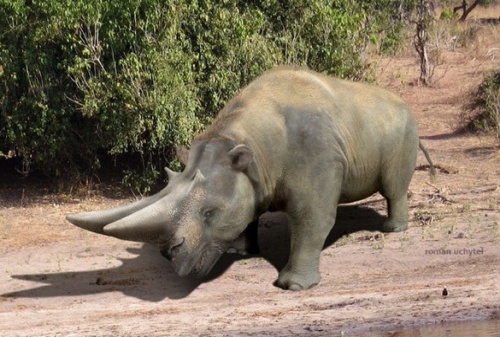
Megaloceros (Megaloceros giganteus) or Bighorn deer, appeared about 300 thousand years ago and died out at the end of the Ice Age. Inhabited Eurasia, from the British Isles to China, preferring open landscapes with sparse tree vegetation. The big-horned deer was the size of a modern elk. The male's head was decorated with colossal horns, greatly expanded at the top in the shape of a spade with several branches, with a span of 200 to 400 cm, and weighing up to 40 kg. Scientists do not have a consensus on what led to the emergence of such huge and, apparently, inconvenient jewelry for the owner.
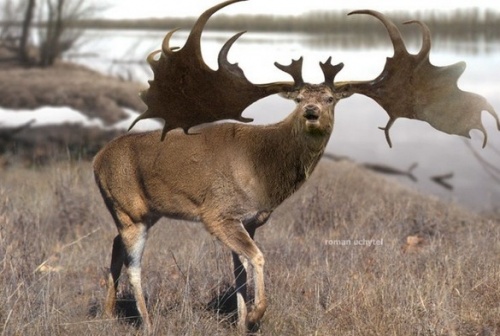
It is likely that the luxurious horns of males, intended for tournament fights and attracting females, were quite a hindrance in everyday life. Perhaps, when forests replaced the tundra-steppe and forest-steppe, it was the colossal horns that caused the extinction of the species. He could not live in the forests, because with such a “decoration” on his head it was impossible to walk through the forest.
Astrapoteria (Astrapotherium magnum) - a genus of large ungulates from the late Oligocene - middle Miocene South America. They are the most well-studied representatives of the order Astrapotheria. They were quite large animals - their body length reached 288 cm, height was 137 cm, and weight, apparently, reached 600 - 800 kg.
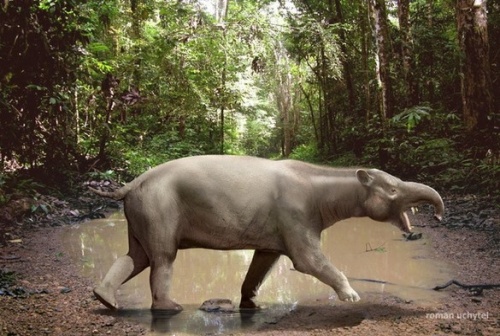
Titanoides (Titanoides) lived 60 million years ago on the American continent and were the first truly large mammals. The area where Titanoides lived was subtropical with swampy forest, similar to modern southern Florida. They probably ate roots, leaves, and tree bark; they also did not disdain small animals and carrion. They were distinguished by the presence of terrifying fangs - sabers, on a huge, almost half-meter skull. Overall, they were powerful beasts, weighing about 200 kg. and body length up to 2 meters.
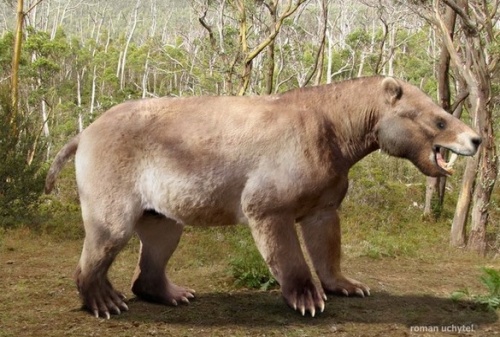
Stilinodon (Stylinodon) is the most famous and last species of taeniodonts, living about 45 million years ago during the Middle Eocene in North America. Teniodonts were among the most rapidly evolving mammals after the extinction of dinosaurs. They are probably related to ancient primitive insectivorous animals, from which they apparently originated. The largest representatives, such as Stylinodon, reached the size of a pig or medium-sized bear and weighed up to 110 kg. The teeth had no roots and had constant growth.
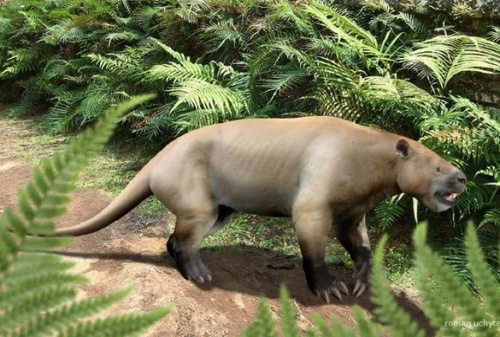
Teniodonts were strong, muscular animals. Their five-fingered limbs developed powerful claws adapted for digging. All this suggests that taeniodonts ate solid plant food (tubers, rhizomes, etc.), which they dug out of the ground with powerful claws. It is believed that they were the same active diggers and led a similar burrowing lifestyle.
Pantolambda (Pantolambda) is a relatively large North American pantodont, about the size of a sheep, that lived in the mid-Paleocene. The oldest representative of the order. Panthodonts evolved from Cimolestes and are related to early ungulates. It is likely that Pantolambda's diet was varied and not very specialized. The menu included shoots and leaves, mushrooms and fruits, which could be supplemented with insects, worms, or carrion.
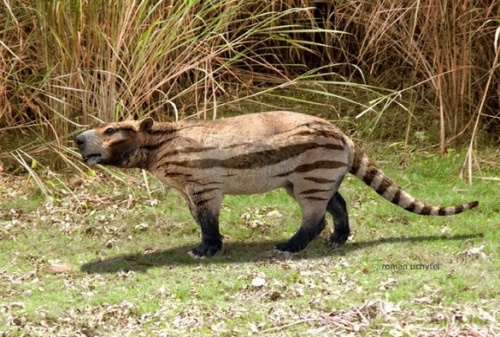
Coryphodons (Coryphodon) were widespread in the lower Eocene 55 million years ago, at the end of which they became extinct. The genus Coryphodon appeared in Asia in the early Eocene era, and then migrated to the territory of modern North America, where it probably replaced the native pantodont Barylambda. The height of the corfodon was about a meter and its weight was approximately 500 kg. Probably, these animals preferred to settle in forests or near water bodies.
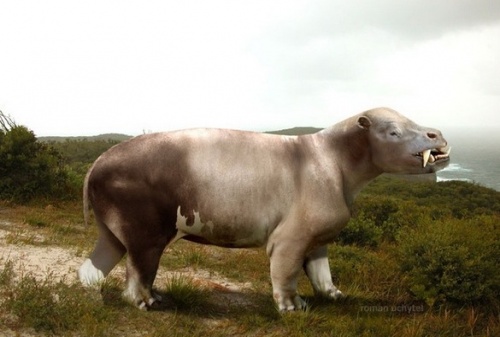
The basis of their diet was leaves, young shoots, flowers and all kinds of marsh vegetation. Amblypods, as animals that had a very small brain and were characterized by a very imperfect structure of teeth and limbs, could not coexist for long with the new, more progressive ungulates that took their place.
Kvabebigiraksy (Kvabebihyrax kachethicus) is a genus of very large fossil hyraxes of the pliohyracid family. They lived only in Transcaucasia (in Eastern Georgia) in the late Pliocene, 3 million years ago. They were distinguished by their large size, the length of their massive body reached 1.5 m. The protrusion of the quabebigirax's eye sockets above the surface of the forehead, like a hippopotamus, indicates the ability of quabebigirax to hide in water. Perhaps it is in aquatic environment the Kwabeb hyrax sought protection in a moment of danger.
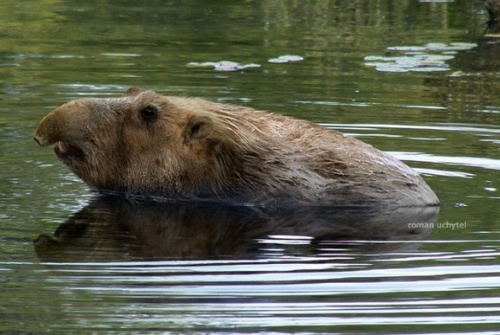
Celodonts (Coelodonta antiquitatis) - fossil woolly rhinoceroses, adapted to life in the arid and cool conditions of the open landscapes of Eurasia. They existed from the late Pliocene to the early Holocene. They were large, relatively short-legged animals with a high nape and an elongated skull bearing two horns. The length of their massive body reached 3.2–4.3 m, the height at the withers was 1.4–2 m.
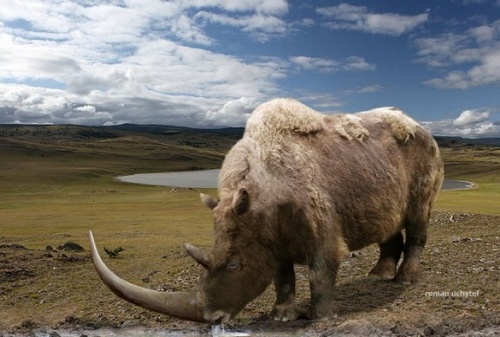
A characteristic feature of these animals was a well-developed woolly coat, which protected them from low temperatures and cold winds. The low-set head with square lips made it possible to collect the main food - the vegetation of the steppe and tundra-steppe. From archaeological finds it follows that the woolly rhinoceros was hunted by Neanderthals about 70 thousand years ago.
Embolotherium (Embolotherium ergilense) - representatives of the family Brontotheriidae of the order Unpaired. These are large land mammals, larger than rhinoceroses. The group was widely represented in the savanna landscapes of Central Asia and North America, mainly in the Oligocene. The skull size of 125 cm of condylobasal length suggests the growth of ergilensis from a large African elephant under 4m at the withers and weight about 7 tons.
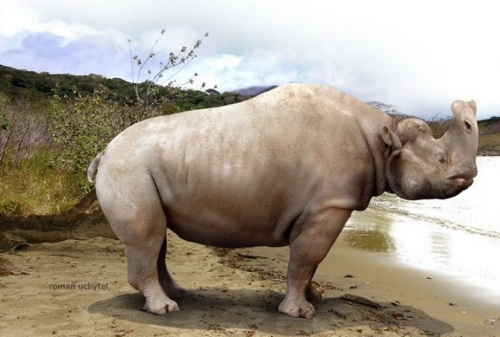
Palorchestes (Palorchestes azael) is a genus of marsupials that lived in Australia in the Miocene and became extinct in the Pleistocene about 40 thousand years ago, after humans arrived in Australia. Reached 1 meter at the withers. The animal's muzzle ended with a small proboscis, for which Palorchests are called marsupial tapirs, to which they are somewhat similar. In fact, palorchests are quite close relatives of wombats and koalas.
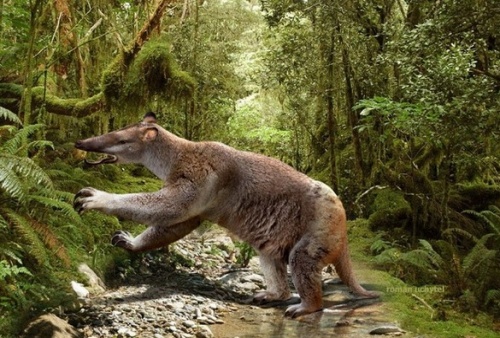
Synthetoceras (Synthetoceras tricornatus) lived in the Miocene, 5-10 million years ago, in North America. The most characteristic difference between these animals is their bony “horns”. It is unknown whether they were covered with a cornea, like modern cattle, but it is clear that the antlers did not change annually, like deer. Synthetoceras belonged to the extinct North American family Protoceratidae, and is believed to be related to camels. Protoceratids looked completely different, although the structure of the lower parts of their limbs was similar to that of camels, which made it possible to place such different animals in one group.
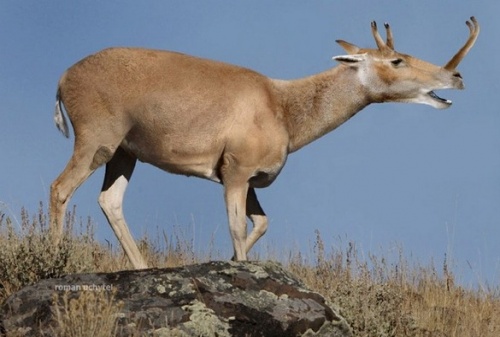
Meritherium (Moeritherium) - the oldest famous representative proboscis It was the size of a tapir and probably resembled this animal in appearance, having a rudimentary trunk. Reached 2 m in length and 70 cm in height. Weighed approximately 225 kg. The second pairs of incisors in the upper and lower jaws were greatly enlarged; their further hypertrophy in later proboscideans led to the formation of tusks. Lived in the late Eocene and Oligocene in North Africa (from Egypt to Senegal). It ate plants and algae. According to the latest data, modern elephants had distant ancestors who lived mainly in water.

Deinotherium (Deinotherium giganteum) - the largest land animals of the late Miocene - middle Pliocene. The body length of representatives of various species ranged from 3.5-7 m, height at the withers reached 3-5 m (on average - 3.5-4 m), and weight could reach 8-10 tons. Outwardly, they resembled modern elephants , however, they differed from them in proportions.
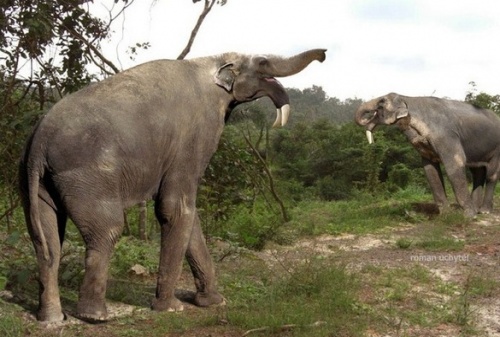
Stegotetrabelodon (Stegotetrabelodon) is a representative of the elephantid family, which means that elephants themselves used to have 4 well-developed tusks. The lower jaw was longer than the upper, but its tusks were shorter. When the jaws closed, the lower tusks entered the gap between the upper ones. At the end of the Miocene (5 million years ago), proboscideans began to lose their lower tusks.
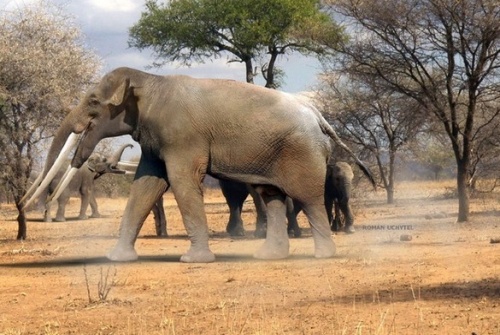
Andrewsarch (Andrewsarchus), perhaps the largest terrestrial carnivorous mammal. Andrewsarchus is represented as a long-bodied, short-legged beast with a huge head. The length of the skull is 834 mm, the width of the zygomatic arches is 560 mm, but the dimensions can be much larger. According to modern reconstructions, if we assume relatively large head sizes and shorter leg lengths, then the body length could reach up to 3.5 meters (without the 1.5 meter tail), the height at the shoulders could be up to 1.6 meters. The weight could reach one ton. Andrewsarchus is a primitive ungulate, close to the ancestors of whales and artiodactyls.
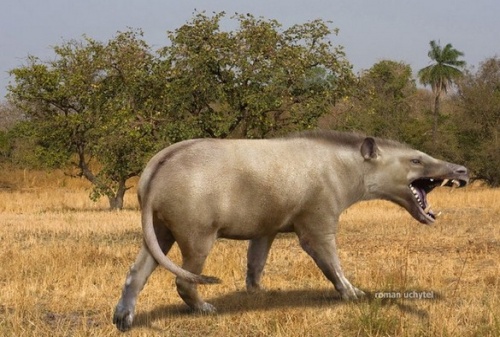
Amphicyonids (Amphicyon major) or dog-bears became widespread in Europe from the late Oligocene (2 million years ago). The proportions of Amphicyon major were a mixture of bear and cat features. Like bears, his remains were found in Spain, France, Germany, Greece and Turkey. The average weight of males of Amphicyon major is 212 kg, and females - 122 kg (almost the same as modern lions). Amphicyon major was an active predator, and its teeth were well adapted for crunching bones.
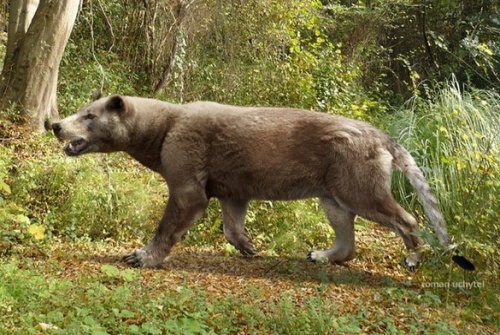
Giant sloths- a group of several different species of sloths, notable for their particularly large sizes. They arose in the Oligocene about 35 million years ago and lived on the American continents, reaching a weight of several tons and a height of 6 m. Unlike modern sloths, they lived not in trees, but on the ground. They were clumsy, slow animals with low, narrow skulls and very little brain matter.
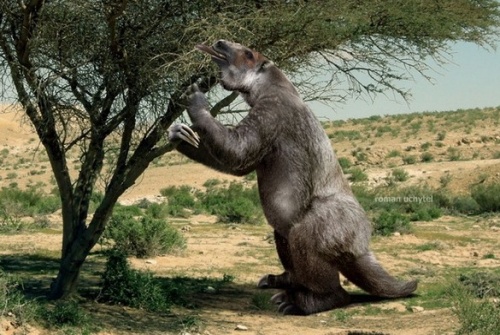
Despite its great weight, the animal stood on its hind legs and, leaning its forelimbs on the tree trunk, reached for succulent leaves. Leaves were not the only food of these animals. They also ate cereals, and perhaps did not disdain carrion. People settled the American continent between 30 and 10 thousand years ago, and the last giant sloths disappeared from the continent about 10 thousand years ago. This suggests that these animals were hunted. They were probably easy prey because, like their modern relatives, they moved very slowly.
Arctotherium (Arctotherium angustidens) is the largest short-faced bear known at this time. Representatives of this species reached 3.5 m in length and weighed about 1600 kg. The height at the withers reached 180 cm. Arctotherium angustidens lived in the Pleistocene, on the Argentine plains. At one time (2 million - 500 thousand years ago) it was the largest predator on the planet.
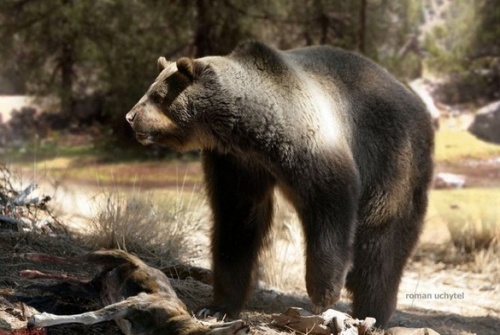
Uintatherium (Uintatherium) is a mammal from the order Dinocerata. Most characteristic- three pairs of horn-like outgrowths on the roof of the skull (parietal and maxillary bones), more developed in males. The outgrowths were covered with skin, like the ossicones of giraffes.
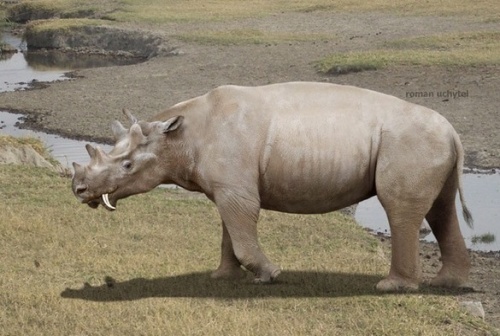
Toxodon (Toxodon) - the largest representative of the toxodont family (Toxodontidae) and the order Notoungulata, was endemic to South America. The genus Toxodon formed at the end of the Pliocene and survived until the very end of the Pleistocene. With its massive build and large size, Toxodon resembled a hippopotamus or rhinoceros. The height at the shoulders was approximately 1.5 meters, and the length was about 2.7 meters (excluding the short tail).
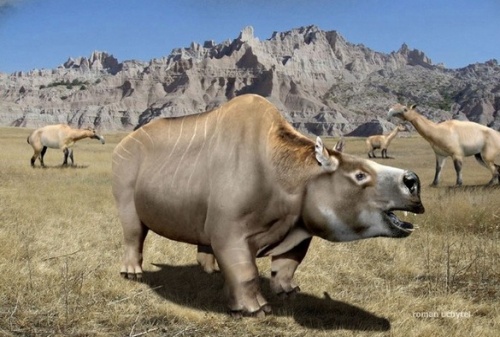
Tilakosmil (Thylacosmilus atrox) is a predatory marsupial of the order Sparassodonta, which lived in the Miocene (10 million years ago). Reached the size of a jaguar. The upper canines are clearly visible on the skull, constantly growing, with huge roots continuing into the frontal region and long protective “blades” on the lower jaw. The upper incisors are missing. He probably hunted large herbivores. Thylacosmila is often called a marsupial tiger, by analogy with another formidable predator - the marsupial lion (Thylacoleo carnifex). It died out at the end of the Pliocene, unable to withstand competition with the first saber-toothed cats that settled the continent.
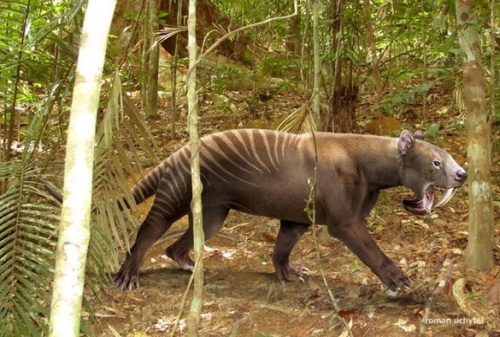
Sarcastodon (Sarkastodon mongoliensis) is one of the largest mammalian land predators of all time. This huge oxyenid lived in Central Asia. The Sarcastodon skull discovered in Mongolia is about 53 cm long, and the width at the zygomatic arches is approximately 38 cm. The body length, apparently, was 2.65 meters, excluding the tail. Sarcastodon looked like a cross between a cat and a bear, only weighing a ton. Perhaps he led a lifestyle similar to that of a bear, but was much more carnivorous, and did not disdain carrion, driving away weaker predators.
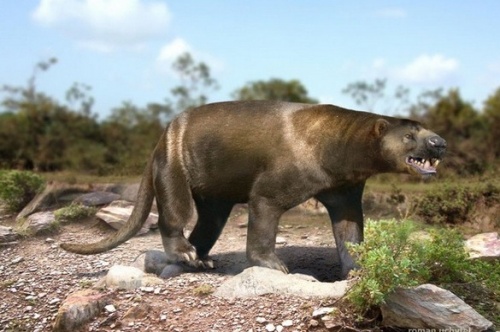
Mongoloterium (Prodinoceras Mongolotherium) is a species of mammal of the extinct order Dinocerata, family Uintatheridae. It is considered one of the most primitive representatives of the order.
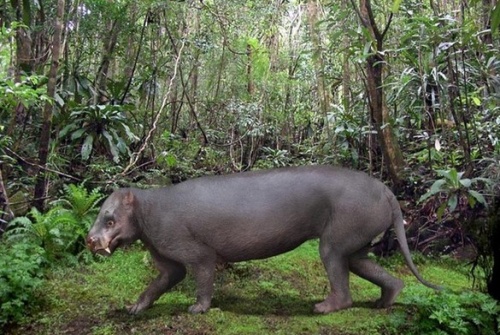
Terrible Birds(sometimes called fororakosov), who lived 23 million years ago, differed from their fellows in their massive skull and beak. Their height reached three meters, and they were formidable predators. Scientists created a three-dimensional model of the bird's skull and found that the bones of the head were strong and rigid in the vertical and longitudinal-transverse directions, while in the transverse direction the skull was quite fragile.
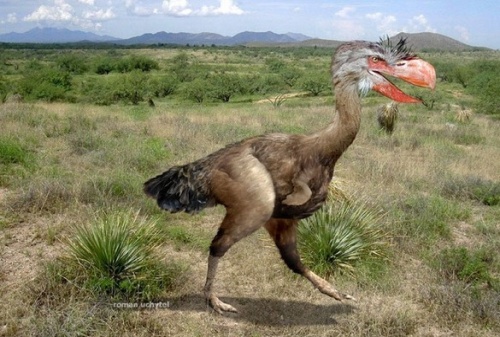
This means that the fororacos would not be able to grapple with struggling prey. The only option is to beat the victim to death with vertical blows of the beak, as if with an ax. The only competitor to the terrible bird was most likely the marsupial saber-toothed tiger (Thylacosmilus). Scientists believe that these two predators were once at the top of the food chain. Thylacosmil was a stronger animal, but Paraphornis surpassed it in speed and agility.
In the hare family ( Leporidae), also had their giants. In 2005, a giant rabbit was described from the island of Menorca (Balearic Islands, Spain) and given the name Nurogalus (Nuralagus rex). The size of a dog, it could reach a weight of 14 kg. According to scientists, such a large size of the rabbit is due to the so-called island rule. According to this principle, large species, once on the islands, decrease over time, while small ones, on the contrary, increase.
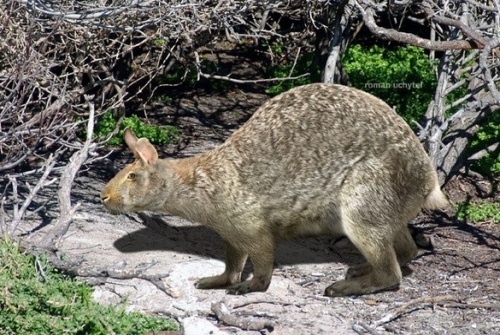
Nurogalus had relatively small eyes and ears, which did not allow him to see and hear well - he did not have to fear an attack, because. there were no large predators on the island. In addition, scientists believe that due to reduced paws and rigidity of the spine, the “king of rabbits” lost the ability to jump and moved on land exclusively in small steps.
Megistotherium (Megistotherium osteothlastes) - a giant hyaenodontid that lived in the early and middle Miocene (20-15 million years ago). It is considered one of the largest land mammal predators to ever exist. Its fossilized remains have been found in Eastern and Northern East Africa and in South Asia. The length of the body with the head was about 4 m + the length of the tail is supposedly 1.6 m, the height at the withers is up to 2 m. The weight of Megistotherium is estimated at 880-1400 kg.
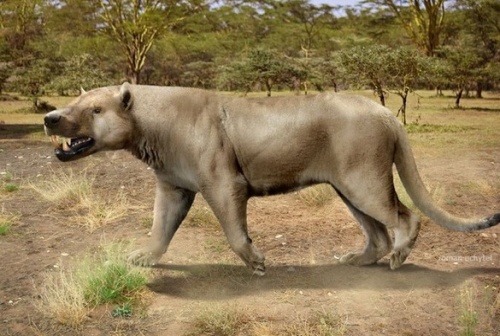
Woolly Mammoth (Mammuthus primigenius) appeared 300 thousand years ago in Siberia, from where it spread to North America and Europe. The mammoth was covered with coarse wool, up to 90 cm long. A layer of fat almost 10 cm thick served as additional thermal insulation. The summer coat was significantly shorter and less dense. They were most likely painted dark brown or black. With small ears and a short trunk compared to modern elephants, the woolly mammoth was well adapted to cold climates. Woolly mammoths were not as huge as is often assumed.
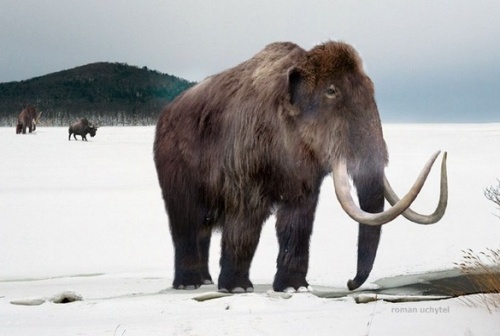
Adult males reached a height of 2.8 to 4 m, which is not much larger than modern elephants. However, they were significantly more massive than elephants, reaching a weight of up to 8 tons. A noticeable difference from living species of proboscis was the strongly curved tusks, a special growth on the top of the skull, a high hump and a steeply sloping rear part of the back. The tusks found to this day reached a maximum length of 4.2 m and a weight of 84 kg. On average, however, they were 2.5 m long and weighed 45 kg.
In addition to the woolly northern mammoths, there were also southern ones without wool. In particular, the Columbian mammoth (Mammuthus columbi), which was one of the largest representatives of the elephant family that ever existed. The height at the withers of adult males reached 4.5 m, and their weight was about 10 tons. It was closely related to the six-hundredth mammoth (Mammuthus primigenius) and came into contact with the northern border of its range. Lived in the vast expanses of North America.
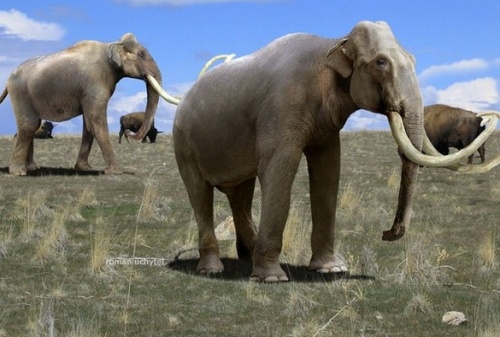
The most northern places finds are located in southern Canada, the southernmost in Mexico. It ate mainly grasses and lived like today's elephant species in matriarchal groups of two to twenty animals led by a mature female. Adult males approached the herds only during the mating season. Mothers protected mammoth calves from large predators, which was not always successful, as evidenced by the finds of hundreds of baby mammoths in caves near Homotherium. The extinction of the Columbian mammoth occurred at the end of the Pleistocene about 10 thousand years ago.
Cubanochoerus (Kubanochoerus robustus) is a large representative of the pig family of the order Artiodactylae. Skull length 680 mm. The facial part is highly elongated and twice as long as the brain section. A distinctive feature of this animal is the presence of horn-like outgrowths on the skull. One of them, a large one, was located in front of the eye sockets on the forehead, behind it were a pair of small protrusions on the sides of the skull.
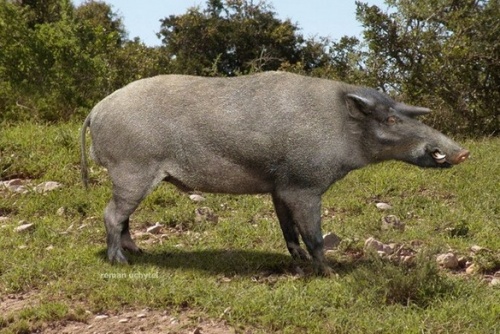
It is possible that fossil pigs used these weapons during ritual fights between males, as African wild boars do today. The upper fangs are large, rounded, curved upward, the lower ones are triangular. In size, Cubanochoerus exceeded the modern wild boar and weighed more than 500 kg. One genus and one species are known from the Belomechetskaya locality of the Middle Miocene in the North Caucasus.
Gigantopithecus (Gigantopithecus) is an extinct genus of great apes that lived in the territory of modern India, China and Vietnam. According to experts, Gigantopithecus had a height of up to 3 meters and weighed from 300 to 550 kg, that is, they were the largest monkeys of all time. At the end of this Pleistocene, Gigantopithecus may have coexisted with Homo erectus, who began to enter Asia from Africa.
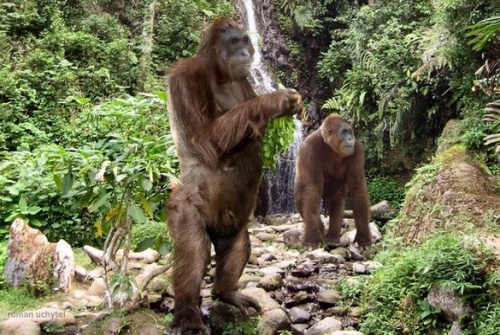
Fossil remains indicate that Gigantopithecus was the largest primate of all time. They were probably herbivores and walked on all fours, feeding mainly on bamboo, sometimes adding seasonal fruits to their food. However, there are theories that prove the omnivorous nature of these animals. Two species of this genus are known: Gigantopithecus bilaspurensis, which lived between 9 and 6 million years ago in China, and Gigantopithecus blacki, which lived in northern India at least 1 million years ago. Sometimes a third species, Gigantopithecus giganteus, is isolated.
Although it is not completely known what exactly caused their extinction, most researchers believe that climate change and competition for food sources from other, more adaptable species - pandas and humans - were among the main reasons. The closest relative of the existing species is the orangutan, although some experts consider Gigantopithecus to be closer to gorillas.
Diprotodon (Diprotodon) or " marsupial hippopotamus" is the largest known marsupial to ever live on earth. Diprotodon belongs to the Australian megafauna, a group of unusual species that lived in Australia from approximately 1.6 million to 40 thousand years ago. Diprotodon bones, including complete skulls and skeletons, as well as hair and footprints, have been found in many places in Australia.
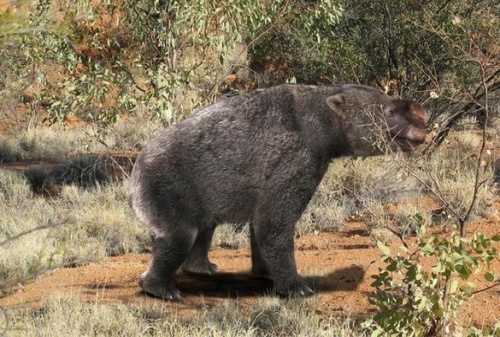
Sometimes the skeletons of females are discovered along with the skeletons of the cubs that were once in the pouch. The largest specimens were approximately the size of a hippopotamus: about three meters in length and about two meters at the withers. The closest living relatives of diprotodons are wombats and koalas. Therefore, diprotodons are sometimes called giant wombats. It cannot be ruled out that the last diprotodons became extinct already in historical times, and also that the appearance of humans on the mainland was one of the reasons for their disappearance.
Deodon (Daeodon) is an Asian entelodont that migrated to North America around the end of the Oligocene era (20 million years ago). "Giant pigs" or "pigwolves" were four-legged land omnivores with massive jaws and teeth that allowed them to crush and eat large animals, including bones. With a height of more than 2 m at the withers, it took food from smaller predators.
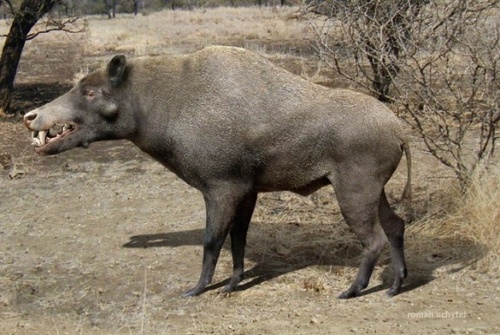
Chalicotherium (Chalicotherium). Chalicotheriums are a family of the equid order. They lived from the Eocene to the Pliocene (40-3.5 million years ago). They reached the size of a large horse, which they were probably somewhat similar in appearance to. They had a long neck and long front legs, four-toed or three-toed. The toes ended in large split claw phalanges, on which were not hooves, but thick claws.
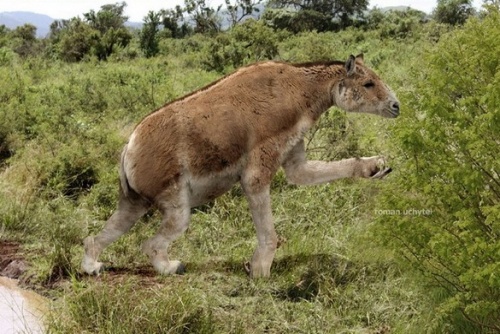
Barylambda (Barylambda faberi) - a primitive pantodont, lived 60 million years ago in America, was one of the largest mammals of the Paleocene. With a length of 2.5 m and a weight of 650 kg, Barylambda slowly moved on short powerful legs ending in five fingers with hoof-shaped claws. She ate bushes and leaves. There is an assumption that Barylambda occupied an ecological niche similar to ground sloths, with the tail serving as a third point of support.
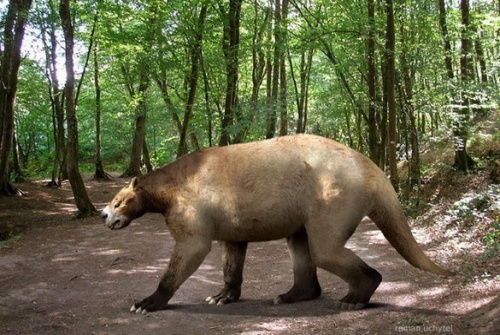
Argentavis (Argentavis magnificens) is the largest flying bird known to science in the entire history of the Earth, which lived 5-8 million years ago in Argentina. It belonged to the now completely extinct family of teratorns, birds that are quite closely related to American vultures, with which it was part of the order of storks (Ciconiiformes).
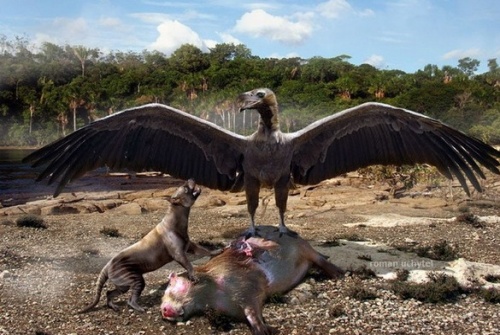
Argentavis weighed about 60-80 kg, and its wingspan reached 8 m. (For comparison, the wandering albatross has the largest wingspan among existing birds - 3.25 m.) The Argentavis skull was 45 cm long, and the humerus was as long as more than half a meter. Apparently the basis of his diet was carrion.
He could not play the role of a giant eagle. The fact is that when diving from a height to high speed, a bird of this size has a high probability of crashing. In addition, the paws of Argentavis are poorly adapted to grasping prey, and are similar to the paws of American vultures, and not to falcons, whose paws are perfectly adapted for this purpose. Like American vultures, Argentavis's claws were likely relatively weak, but its beak was very powerful, allowing it to feed on dead animals of any size.
In addition, Argentavis probably sometimes attacked small animals, as modern vultures do.
Thalassocnus– incompletely edentate from the Miocene and Pliocene (10-5 million years ago) of South America. Probably led a semi-aquatic lifestyle.
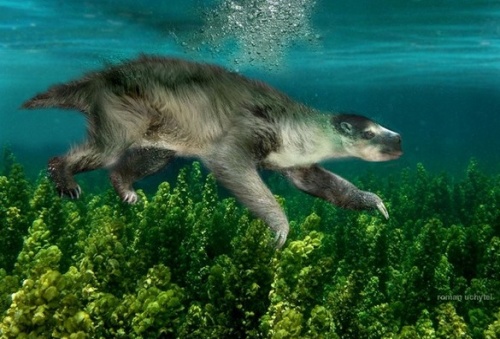
The continuous evolution of all life on earth is the reason that some species, almost disappearing without a trace, are replaced by new ones. But the scale of changes in nature is such that it is almost impossible for a person with his short life to trace this process. So you have to be content scientific information about the facts of the disappearance and emergence of individual representatives of the fauna, substantiating the reasons by assumption or analysis of conditions.
Some of these reasons are natural (changes in climate and vegetation, the appearance of predators in the habitat of herbivores), others are anthropogenic (related to human activity). It was he, the “king of nature,” who contributed to the fact that many representatives of the detachment of “our little brothers” irrevocably disappeared from the face of the earth. Hunting for the purpose of obtaining meat and wool, deforestation, land reclamation, building roads, construction - this is an incomplete list of interventions leading to the disappearance of entire species of animals and birds.
Today, humanity is aware of the irreparable harm caused to nature and is trying to correct the mistakes. One of the steps taken by people was the adoption of laws aimed at protecting rare animals. As well as educational work aimed at influencing people’s consciousness and their feelings. Interesting facts about extinct animals and birds should make people wonder why the next generation will no longer be able to witness the life of these creatures, and perhaps some of those that exist today.
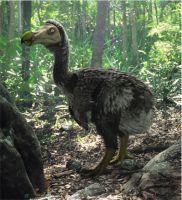 Dodo (dodo)- flightless, large bird of the order Pigeonidae. She inhabited the island of Mauritius, her food was vegetation. She usually laid the only egg on the ground. The dodo was exterminated in the 17th century by people and animals brought to the island.
Dodo (dodo)- flightless, large bird of the order Pigeonidae. She inhabited the island of Mauritius, her food was vegetation. She usually laid the only egg on the ground. The dodo was exterminated in the 17th century by people and animals brought to the island.
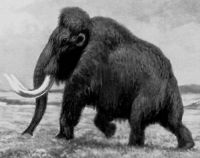 Mammoth- a species of elephant that lived approximately 1.5 million years ago. Mammoths were much larger than elephants and covered with hair. Their food was grass and bushes. They were often hunted by ancient people. So far, the reason for their disappearance has not been fully established. One of the supposed reasons for this extinction is a very rapid and severe cooling on our planet.
Mammoth- a species of elephant that lived approximately 1.5 million years ago. Mammoths were much larger than elephants and covered with hair. Their food was grass and bushes. They were often hunted by ancient people. So far, the reason for their disappearance has not been fully established. One of the supposed reasons for this extinction is a very rapid and severe cooling on our planet.
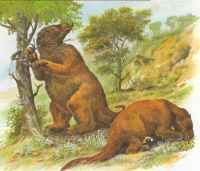 Megatherium- a terrestrial, giant sloth that lived 2 million years ago in South and North America. It had a body up to 6 m long and a rather long and powerful tail. He ate grass and leaves. It had long forelimbs with curved claws.
Megatherium- a terrestrial, giant sloth that lived 2 million years ago in South and North America. It had a body up to 6 m long and a rather long and powerful tail. He ate grass and leaves. It had long forelimbs with curved claws.
![]() Smilodon(also called the saber-toothed tiger) - from the cat family, completely disappeared 2 million years ago. It was larger in size than modern tigers and had long, saber-shaped fangs on its upper jaw. He hunted thick-skinned animals that fed on vegetation - rhinoceroses and ancient elephants.
Smilodon(also called the saber-toothed tiger) - from the cat family, completely disappeared 2 million years ago. It was larger in size than modern tigers and had long, saber-shaped fangs on its upper jaw. He hunted thick-skinned animals that fed on vegetation - rhinoceroses and ancient elephants.
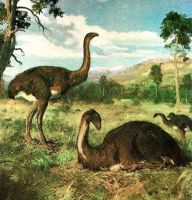 Moa- a large, flightless bird. She had powerful hind limbs. She was about 3 m tall. She lived in New Zealand in the 17th century. As a result of human, unlimited hunting, it disappeared forever.
Moa- a large, flightless bird. She had powerful hind limbs. She was about 3 m tall. She lived in New Zealand in the 17th century. As a result of human, unlimited hunting, it disappeared forever.
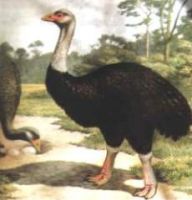 Epiornis- a large, flightless bird, height up to 3 m and weight up to 450 kg. The huge eggs of this bird weighed up to 10 kg.
Epiornis- a large, flightless bird, height up to 3 m and weight up to 450 kg. The huge eggs of this bird weighed up to 10 kg.
Apiornis lived on the island of Madagascar until the 19th century. Extinct from merciless human extermination, as well as from deforestation tropical forests where they usually lived.
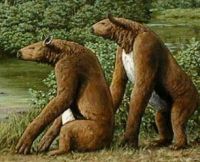 Chalicotherium- belonged to the order of equids. He had a horse's head, strong limbs and claws instead of hooves. Rising on its hind limbs, it reached a height of 5 meters.
Chalicotherium- belonged to the order of equids. He had a horse's head, strong limbs and claws instead of hooves. Rising on its hind limbs, it reached a height of 5 meters.
